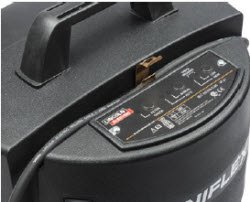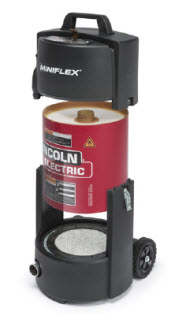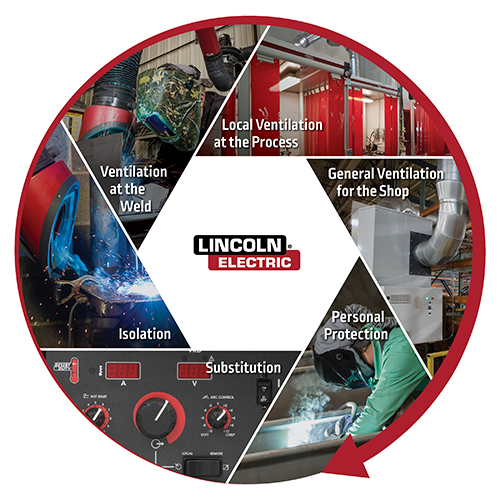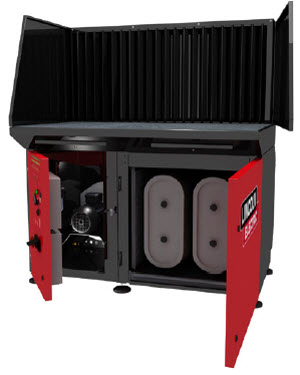Clearing The Air: Importance Of Filter Replacement For Welding Fume Extraction Systems
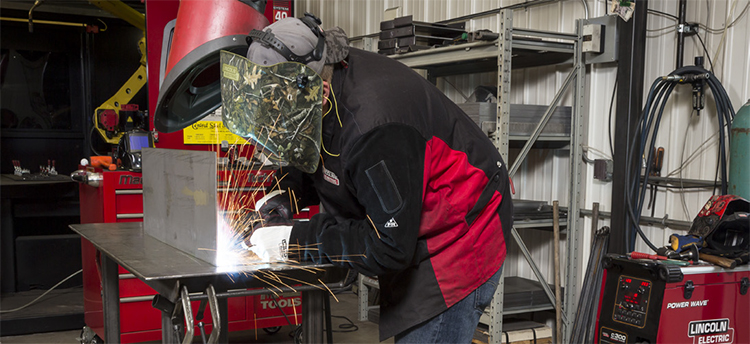
WHAT ARE THE TYPES OF MECHANICAL FILTERS AND WHAT DO I NEED TO KNOW ABOUT EACH?
Pre-filter. The purpose of a pre-filter is to capture larger particulates and remove them from the system so they do not reach the main filter. The pre-filter is typically made from aluminum or steel mesh, and may also act as a spark arrestor.
Main filter. The main filter is designed to capture the majority of the particulates generated from welding and its allied processes. Mechanical filtration can also be used effectively for the grinding process.
After filter. The purpose of the after filter is to filter out any remaining small particulates (approximately 0.1 to 0.3 microns). This is similar to the High-Efficiency Particulate Air (HEPA) filter on a vacuum cleaner.
Lincoln Electric weld fume control products utilize one or more of these filter types, depending on the model.
WHEN SHOULD YOU REPLACE THE FILTER?
- The need for filter replacement is typically indicated by a gauge, an audible tone, an indicator or a combination of these depending on the features of the system. Always reference the instruction manual to find the indicator mechanism on your extraction unit. You may also notice a decrease in extraction capacity and possibly a reduction in extraction of welding fume if the filter has become oversaturated and is not changed.
- The rate of welding fume generation may vary based on the welding processes that are used in your operation and the particular welding settings selected. The choice of shielding gases, where applicable, can also influence fume generation. Stick and flux-cored welding tend to generate a higher volume of fume compared to MIG welding and TIG welding, which typically generate less particulate than the other processes. The welding process and settings used may impact the life expectancy of your filter and you should take them into account when you are setting up your replacement schedule.
- Another factor that will help you anticipate the need to replace your filter includes how many hours and shifts you system is operating. The more hours and shifts worked, the sooner the filter needs replaced.
- Changes in climate or the environment may warrant a filter check and replacement. When companies do extensive maintenance in the summer months, it’s a good time to schedule a replacement of filters. In the fall and winter months, when windows and doors are closed due to cooler weather, it is a good reminder to make regular checks to ensure that the exhaust systems are functioning properly.
WHAT FILTER SHOULD YOU USE?
First, ensure your replacement filters meets welding ventilation requirements established by OSHA and the EPA at the local, state and federal levels.
Second, confirm your replacement filter has the right MERV (Minimal Efficiency Reporting Value). The industrial air filtration industry offers numerous choices of filters – so determining the best option for your welding operation and overall work environment can be challenging.
Fortunately, there is the MERV industry-wide metric for ranking filter performance. The MERV is used to indicate the filter’s particle removal efficiency (PRE) for a specific range of particle size. Rankings are made from MERV 1 to 16; the higher the number, the smaller the particle size and the higher the PRE. The details and method of measuring PRE are provided in ANSI/ASHARE Standard 52.2. Welding typically requires MERV 11, 15 or 16, but welding application and consumable type will dictate what filter MERV rating is required for your system so refer to the ANSI/ASHRAE Standard 52.2 “Understanding MERV” User Guide (November 2014) created by the National Air Filtration Association (NAFA®).
WHY SHOULD YOU CREATE A FILTER REPLACEMENT AND PREVENTIVE MAINTENANCE STRATEGY?
A successful preventive maintenance strategy includes changing the filter on a regular basis. In addition, equipment operation and cleaning should be scheduled and coordinated to ensure that ducting is clean, fume extraction arms are tuned properly and more. Certain tasks must be scheduled at varying service intervals in order to keep the fume extraction equipment from experiencing any unexpected breakdowns. Preventive maintenance for industrial equipment is an effective way to maintain and extend weld fume control equipment operation and life.
When establishing a filter replacement and preventive maintenance strategy, keep the following suggestions in mind:
- Use Lincoln Electric genuine filters rather than a generic replacement filter. Lincoln Electric cannot warrant or ensure proper operation of the unit if a generic filter replacement is used. This can affect the operation of the system.
- Know the regulations, requirements and restrictions that apply to the filter’s disposal. It may be necessary to have the material tested in order to understand if the waste material is regulated. Environmental regulations regarding waste disposal can vary, depending on federal and local requirements.
- Make sure to have a consistent schedule for procuring and installing spare parts and conducting regular service.
- Allow for regular system checks of the cleaning program within the programmable logic controller (PLC) and the differential pressure monitoring system.
- Ensure that employees are not overexposed to airborne dust and contaminants during filter maintenance activities. Take any proactive measures necessary to protect against overexposures such as using protective equipment, disposable coveralls and/or respiratory protection.
WHAT FACTORS AFFECT FILTER DISPOSAL?
- What is your company’s or facility’s hazardous waste generator status?
- Do you have sufficient generator knowledge to “profile” the waste stream?
- Do you need to perform testing to determine what the hazardous waste codes are?
- Do you know the federal, state, and local regulations related to disposal?
If your team is not experienced with these issues, contact a qualified local environmental consultant or your state environmental regulatory agency (EPA) for guidance on the requirements of your state’s environmental rules.
FACTORS THAT COULD ADVERSELY AFFECT FILTER LIFE
- Contaminants can enter the compressed air system, which in turn make their way into the fume control system. Keep your compressed air system as clean, dry and oil-free as possible.
- Additives to the base metal. Be aware of any oily process or coatings (such as anti-spatter agents, rust preventatives, etc.) that have been applied to the base metal. These have a high probability of vaporizing and entering your fume control system.


